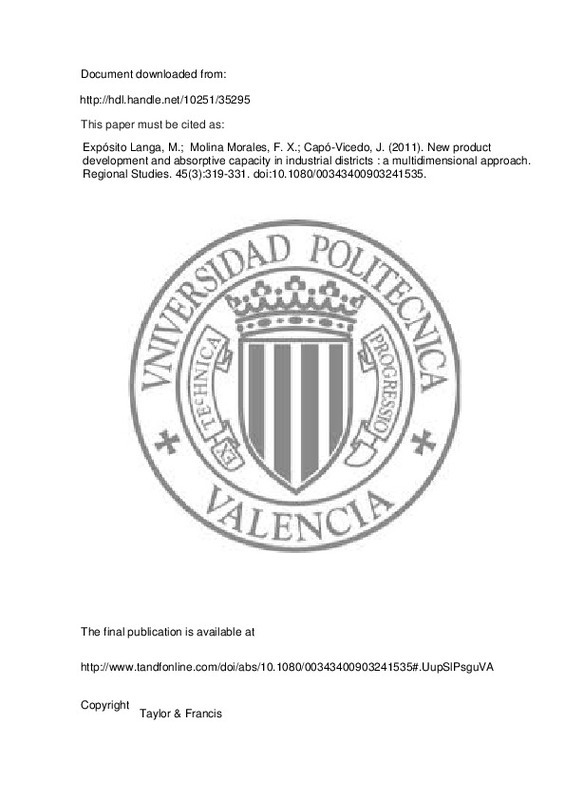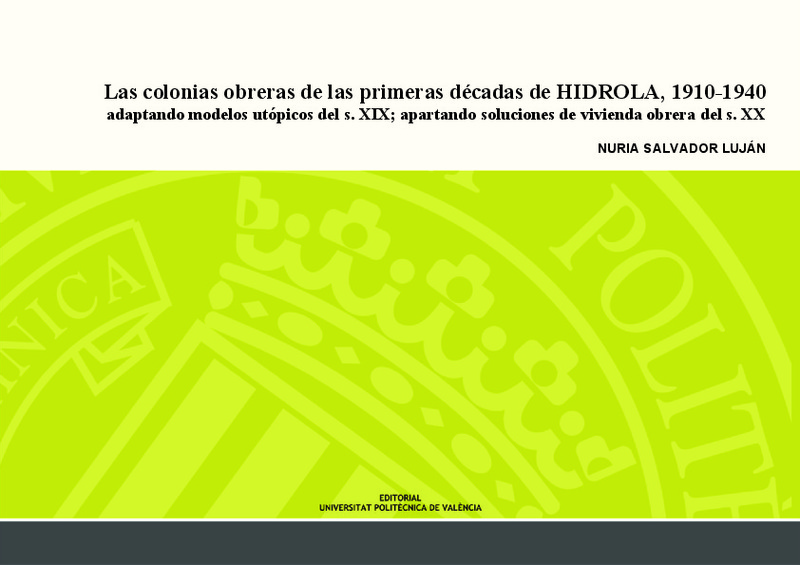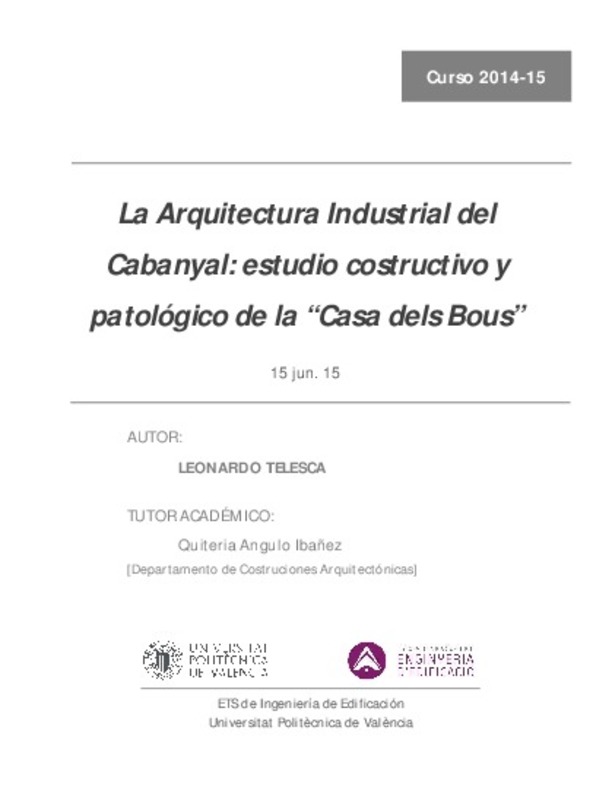JavaScript is disabled for your browser. Some features of this site may not work without it.
Buscar en RiuNet
Listar
Mi cuenta
Estadísticas
Ayuda RiuNet
Admin. UPV
New product development and absorptive capacity in industrial districts : a multidimensional approach
Mostrar el registro sencillo del ítem
Ficheros en el ítem
| dc.contributor.author | Expósito Langa, Manuel
|
es_ES |
| dc.contributor.author | Molina Morales, Francesc Xavier
|
es_ES |
| dc.contributor.author | Capó Vicedo, Josep
|
es_ES |
| dc.date.accessioned | 2014-01-31T10:08:35Z | |
| dc.date.issued | 2010-01-21 | |
| dc.identifier.issn | 0034-3404 | |
| dc.identifier.uri | http://hdl.handle.net/10251/35295 | |
| dc.description.abstract | [EN] This research studies to what extent the absorptive capacity of a firm influences its capacity to exploit new opportunities through new products, particularly in a specific context of industrial districts. A multidimensional approach to the absorptive capacity concept is used to distinguish between identification, assimilation, and exploitation of external knowledge. The population of companies belonging to a Spanish textile district is studied. Findings suggest that information and knowledge that a company receives from external sources provide the company with the necessary abilities to innovate. In the present case, the greater the absorptive capacity, the greater the innovation capacity for the company. © 2011 Regional Studies Association. | es_ES |
| dc.description.abstract | [FR] La mise au point des produits nouveaux et la capacité d¿absorption dans les districts industriels: une façon multi-dimensionnelle, Regional Studies. Cette recherche étudie jusqu¿à quel point la capacité d¿absorption d¿une entreprise influe sur sa capacité d¿exploiter de nouvelles possibilités par moyen des produits nouveaux, notamment dans le contexte des districts industriels. On applique une façon multidimensionnelle à la notion de capacité d¿absorption afin de distinguer entre l¿identification, l¿assimilation et l¿exploitation de la connaissance externe. On étudie le parc d¿entreprises implanté sur un district du textile en Espagne. Les résultats laissent supposer que l¿information et la connaissance que reçoit une entreprise des sources externes fournissent ce dont elles ont besoin pour innover. Il s¿avère de la présente étude que la plus grande est la capacitéd¿absorption, la plus grande est la capacité d¿innovation. | es_ES |
| dc.description.abstract | [DE] In diesem Beitrag untersuchen wir, in welchem Ausmaß sich insbesondere im spezifischen Kontext der Industriebezirke die absorptive Kapazität einer Firma auf ihre Kapazität auswirkt, neue Gelegenheiten durch neue Produkte zu nutzen. Zur Unterscheidung zwischen der Identifizierung, der Assimilation und der Nutzung von externem Wissen wird ein multidimensionaler Ansatz für die absorptive Kapazität herangezogen. Untersucht wurden die Firmen eines Textilbezirks in Spanien. Aus den Ergebnissen geht hervor, dass die Informationen und das Wissen, die eine Firma von externen Quellen bezieht, der Firma die nötigen Fähigkeiten zur Innovation verleihen. Im vorliegenden Fall gilt, dass die innovative Kapazität einer Firma um so größer ausfällt, je größer ihre absorptive Kapazität ist. | es_ES |
| dc.description.abstract | [ES] El presente trabajo estudia el efecto de la capacidad de absorción en la empresa sobre el desarrollo de nuevos productos, dentro de un contexto de distrito industrial. Utilizamos una aproximación multidimensional para el concepto de la capacidad de absorción con el objeto de distinguir entre la identificación, asimilación y explotación de conocimiento. Hemos trabajado con empresas pertenecientes al distrito industrial textil español. Los resultados sugieren que las externalidades que la empresa recibe en forma de información y conocimiento de su entorno, junto a las habilidades internas necesarias, benefician su proceso de innovación. De forma particular, el desarrollo de la capacidad de absorción en la empresa favorece su capacidad innovadora. | es_ES |
| dc.language | Inglés | es_ES |
| dc.publisher | Taylor & Francis | es_ES |
| dc.relation.ispartof | Regional Studies | es_ES |
| dc.rights | Reserva de todos los derechos | es_ES |
| dc.subject | Absorptive capacity | es_ES |
| dc.subject | Industrial district | es_ES |
| dc.subject | Innovation | es_ES |
| dc.subject | Knowledge | es_ES |
| dc.subject | New product development | es_ES |
| dc.subject | Industrial development | es_ES |
| dc.subject | Industrial performance | es_ES |
| dc.subject | Product development | es_ES |
| dc.subject | Textile industry | es_ES |
| dc.subject | Spain | es_ES |
| dc.subject.classification | ORGANIZACION DE EMPRESAS | es_ES |
| dc.title | New product development and absorptive capacity in industrial districts : a multidimensional approach | es_ES |
| dc.type | Artículo | es_ES |
| dc.embargo.lift | 10000-01-01 | |
| dc.embargo.terms | forever | es_ES |
| dc.identifier.doi | 10.1080/00343400903241535 | |
| dc.rights.accessRights | Abierto | es_ES |
| dc.contributor.affiliation | Universitat Politècnica de València. Departamento de Organización de Empresas - Departament d'Organització d'Empreses | es_ES |
| dc.description.bibliographicCitation | Expósito Langa, M.; Molina Morales, FX.; Capó Vicedo, J. (2010). New product development and absorptive capacity in industrial districts : a multidimensional approach. Regional Studies. 45(3):319-331. doi:10.1080/00343400903241535 | es_ES |
| dc.description.accrualMethod | S | es_ES |
| dc.relation.publisherversion | http://www.tandfonline.com/doi/abs/10.1080/00343400903241535#.UupSlPsguVA | es_ES |
| dc.description.upvformatpinicio | 319 | es_ES |
| dc.description.upvformatpfin | 331 | es_ES |
| dc.type.version | info:eu-repo/semantics/publishedVersion | es_ES |
| dc.description.volume | 45 | es_ES |
| dc.description.issue | 3 | es_ES |
| dc.relation.senia | 40652 | |
| dc.description.references | Acs, Z., & Audretsch, D. (Eds.). (1991). Innovation and Technological Change. doi:10.3998/mpub.12958 | es_ES |
| dc.description.references | Antonelli, C. (2000). Collective Knowledge Communication and Innovation: The Evidence of Technological Districts. Regional Studies, 34(6), 535-547. doi:10.1080/00343400050085657 | es_ES |
| dc.description.references | Bathelt, H., Malmberg, A., & Maskell, P. (2004). Clusters and knowledge: local buzz, global pipelines and the process of knowledge creation. Progress in Human Geography, 28(1), 31-56. doi:10.1191/0309132504ph469oa | es_ES |
| dc.description.references | Bellandi, M. (1996). Innovation and Change in the Marshallian Industrial District. European Planning Studies, 4(3), 357-368. doi:10.1080/09654319608720351 | es_ES |
| dc.description.references | Belussi, F., Sammarra, A., & Rita Sedita, S. (2008). Managing Long Distance and Localized Learning in the Emilia Romagna Life Science Cluster. European Planning Studies, 16(5), 665-692. doi:10.1080/09654310802049273 | es_ES |
| dc.description.references | Biggiero, L. (2006). Industrial and knowledge relocation strategies under the challenges of globalization and digitalization: the move of small and medium enterprises among territorial systems. Entrepreneurship & Regional Development, 18(6), 443-471. doi:10.1080/08985620600884701 | es_ES |
| dc.description.references | Boix, R., & Galletto, V. (2009). Innovation and Industrial Districts: A First Approach to the Measurement and Determinants of the I-District Effect. Regional Studies, 43(9), 1117-1133. doi:10.1080/00343400801932342 | es_ES |
| dc.description.references | Boschma, R. A., & ter Wal, A. L. J. (2007). Knowledge Networks and Innovative Performance in an Industrial District: The Case of a Footwear District in the South of Italy. Industry & Innovation, 14(2), 177-199. doi:10.1080/13662710701253441 | es_ES |
| dc.description.references | Boynton, A. C., Zmud, R. W., & Jacobs, G. C. (1994). The Influence of IT Management Practice on IT Use in Large Organizations. MIS Quarterly, 18(3), 299. doi:10.2307/249620 | es_ES |
| dc.description.references | Brown, S. L., & Eisenhardt, K. M. (1995). Product Development: Past Research, Present Findings, and Future Directions. The Academy of Management Review, 20(2), 343. doi:10.2307/258850 | es_ES |
| dc.description.references | Caloghirou, Y., Kastelli, I., & Tsakanikas, A. (2004). Internal capabilities and external knowledge sources: complements or substitutes for innovative performance? Technovation, 24(1), 29-39. doi:10.1016/s0166-4972(02)00051-2 | es_ES |
| dc.description.references | Chiarvesio, M., Di Maria, L. and Micelli, S. Innovation and internationalisation of Italian districts: exploitation of global competencies or transfer of local knowledge? Paper presented at the Regional Studies Association International Conference. April12–152003, Pisa, Italy. | es_ES |
| dc.description.references | Child, J. (1984). Organization: A Guide to Problems and Practice. doi:10.4135/9781446280348 | es_ES |
| dc.description.references | Cockburn, I. M., & Henderson, R. M. (2003). Absorptive Capacity, Coauthoring Behavior, and the Organization of Research in Drug Discovery. The Journal of Industrial Economics, 46(2), 157-182. doi:10.1111/1467-6451.00067 | es_ES |
| dc.description.references | Cohen, W. M., & Levinthal, D. A. (1989). Innovation and Learning: The Two Faces of R & D. The Economic Journal, 99(397), 569. doi:10.2307/2233763 | es_ES |
| dc.description.references | Cohen, W. M., & Levinthal, D. A. (1990). Absorptive Capacity: A New Perspective on Learning and Innovation. Administrative Science Quarterly, 35(1), 128. doi:10.2307/2393553 | es_ES |
| dc.description.references | Cohen, W. M., & Levinthal, D. A. (1994). Fortune Favors the Prepared Firm. Management Science, 40(2), 227-251. doi:10.1287/mnsc.40.2.227 | es_ES |
| dc.description.references | Dakhli, M., & De Clercq, D. (2004). Human capital, social capital, and innovation: a multi-country study. Entrepreneurship & Regional Development, 16(2), 107-128. doi:10.1080/08985620410001677835 | es_ES |
| dc.description.references | Deeds, D. L., Decarolis, D., & Coombs, J. (2000). Dynamic capabilities and new product development in high technology ventures. Journal of Business Venturing, 15(3), 211-229. doi:10.1016/s0883-9026(98)00013-5 | es_ES |
| dc.description.references | Evenson, R. E., & Kislev, Y. (1973). Research and Productivity in Wheat and Maize. Journal of Political Economy, 81(6), 1309-1329. doi:10.1086/260129 | es_ES |
| dc.description.references | Giuliani, E., & Bell, M. (2005). The micro-determinants of meso-level learning and innovation: evidence from a Chilean wine cluster. Research Policy, 34(1), 47-68. doi:10.1016/j.respol.2004.10.008 | es_ES |
| dc.description.references | Godfrey, P. C., & Hill, C. W. L. (1995). The problem of unobservables in strategic management research. Strategic Management Journal, 16(7), 519-533. doi:10.1002/smj.4250160703 | es_ES |
| dc.description.references | Grant, R. M. (1991). The Resource-Based Theory of Competitive Advantage: Implications for Strategy Formulation. California Management Review, 33(3), 114-135. doi:10.2307/41166664 | es_ES |
| dc.description.references | Grant, R. M. (1996). Prospering in Dynamically-Competitive Environments: Organizational Capability as Knowledge Integration. Organization Science, 7(4), 375-387. doi:10.1287/orsc.7.4.375 | es_ES |
| dc.description.references | Guerrieri, P., & Pietrobelli, C. (2006). Old and New Forms of Clustering and Production Networks in Changing Technological Regimes. Science, Technology and Society, 11(1), 9-38. doi:10.1177/097172180501100102 | es_ES |
| dc.description.references | Humphrey, J., & Schmitz, H. (2002). How does insertion in global value chains affect upgrading in industrial clusters? Regional Studies, 36(9), 1017-1027. doi:10.1080/0034340022000022198 | es_ES |
| dc.description.references | Jansen, J. J. P., Van Den Bosch, F. A. J., & Volberda, H. W. (2005). Managing Potential and Realized Absorptive Capacity: How do Organizational Antecedents Matter? Academy of Management Journal, 48(6), 999-1015. doi:10.5465/amj.2005.19573106 | es_ES |
| dc.description.references | Lane, P. J., Koka, B. R., & Pathak, S. (2006). The Reification of Absorptive Capacity: A Critical Review and Rejuvenation of the Construct. Academy of Management Review, 31(4), 833-863. doi:10.5465/amr.2006.22527456 | es_ES |
| dc.description.references | Lane, P. J., & Lubatkin, M. (1998). Relative absorptive capacity and interorganizational learning. Strategic Management Journal, 19(5), 461-477. doi:10.1002/(sici)1097-0266(199805)19:5<461::aid-smj953>3.0.co;2-l | es_ES |
| dc.description.references | Lane, P. J., Salk, J. E., & Lyles, M. A. (2001). Absorptive capacity, learning, and performance in international joint ventures. Strategic Management Journal, 22(12), 1139-1161. doi:10.1002/smj.206 | es_ES |
| dc.description.references | Lenox, M., & King, A. (2004). Prospects for developing absorptive capacity through internal information provision. Strategic Management Journal, 25(4), 331-345. doi:10.1002/smj.379 | es_ES |
| dc.description.references | Liu, X., & White, R. S. (1997). The relative contributions of foreign technology and domestic inputs to innovation in Chinese manufacturing industries. Technovation, 17(3), 119-125. doi:10.1016/s0166-4972(96)00090-9 | es_ES |
| dc.description.references | Malipiero, A., Munari, F. and Sobrero, M. Focal firms as technological gatekeepers within industrial districts: knowledge creation and dissemination in the Italian packaging machinery industry. Paper presented at the Danish Research Unit for Industrial Dynamics (DRUID) Academy Winter 2005 PhD Conference. Aalborg: Aalborg University. | es_ES |
| dc.description.references | Mangematin, V., & Nesta, L. (1999). What kind of knowledge can a firm absorb? International Journal of Technology Management, 18(3/4), 149. doi:10.1504/ijtm.1999.002771 | es_ES |
| dc.description.references | Maskell, P. (2001). Towards a Knowledge-based Theory of the Geographical Cluster. Industrial and Corporate Change, 10(4), 921-943. doi:10.1093/icc/10.4.921 | es_ES |
| dc.description.references | McEvily, B., & Zaheer, A. (1999). Bridging ties: a source of firm heterogeneity in competitive capabilities. Strategic Management Journal, 20(12), 1133-1156. doi:10.1002/(sici)1097-0266(199912)20:12<1133::aid-smj74>3.0.co;2-7 | es_ES |
| dc.description.references | Meeus, M. T. H., Oerlemans, L. A. G., & Hage, J. (2001). Patterns of Interactive Learning in a High-tech Region. Organization Studies, 22(1), 145-172. doi:10.1177/017084060102200106 | es_ES |
| dc.description.references | Molina-Morales, F. X., & Martínez-Fernández, M. T. (2004). Factors That Identify Industrial Districts: An Application in Spanish Manufacturing Firms. Environment and Planning A: Economy and Space, 36(1), 111-126. doi:10.1068/a3618 | es_ES |
| dc.description.references | Morrison, A. (2008). Gatekeepers of Knowledgewithin Industrial Districts: Who They Are, How They Interact. Regional Studies, 42(6), 817-835. doi:10.1080/00343400701654178 | es_ES |
| dc.description.references | Mowery, D. C. (1983). The relationship between intrafirm and contractual forms of industrial research in American manufacturing, 1900–1940. Explorations in Economic History, 20(4), 351-374. doi:10.1016/0014-4983(83)90024-4 | es_ES |
| dc.description.references | Mowery, D. C., Oxley, J. E., & Silverman, B. S. (1996). Strategic alliances and interfirm knowledge transfer. Strategic Management Journal, 17(S2), 77-91. doi:10.1002/smj.4250171108 | es_ES |
| dc.description.references | Nieto, M., & Quevedo, P. (2005). Absorptive capacity, technological opportunity, knowledge spillovers, and innovative effort. Technovation, 25(10), 1141-1157. doi:10.1016/j.technovation.2004.05.001 | es_ES |
| dc.description.references | Spender, J.-C. (1996). Making knowledge the basis of a dynamic theory of the firm. Strategic Management Journal, 17(S2), 45-62. doi:10.1002/smj.4250171106 | es_ES |
| dc.description.references | Stock, G. N., Greis, N. P., & Fischer, W. A. (2001). Absorptive capacity and new product development. The Journal of High Technology Management Research, 12(1), 77-91. doi:10.1016/s1047-8310(00)00040-7 | es_ES |
| dc.description.references | Szulanski, G. (1996). Exploring internal stickiness: Impediments to the transfer of best practice within the firm. Strategic Management Journal, 17(S2), 27-43. doi:10.1002/smj.4250171105 | es_ES |
| dc.description.references | Tsai, W. (2001). KNOWLEDGE TRANSFER IN INTRAORGANIZATIONAL NETWORKS: EFFECTS OF NETWORK POSITION AND ABSORPTIVE CAPACITY ON BUSINESS UNIT INNOVATION AND PERFORMANCE. Academy of Management Journal, 44(5), 996-1004. doi:10.2307/3069443 | es_ES |
| dc.description.references | Tu, Q., Vonderembse, M. A., Ragu-Nathan, T. S., & Sharkey, T. W. (2005). Absorptive capacity: Enhancing the assimilation of time-based manufacturing practices. Journal of Operations Management, 24(5), 692-710. doi:10.1016/j.jom.2005.05.004 | es_ES |
| dc.description.references | Tushman, M., & Nadler, D. (1986). Organizing for Innovation. California Management Review, 28(3), 74-92. doi:10.2307/41165203 | es_ES |
| dc.description.references | Uzzi, B. (1996). The Sources and Consequences of Embeddedness for the Economic Performance of Organizations: The Network Effect. American Sociological Review, 61(4), 674. doi:10.2307/2096399 | es_ES |
| dc.description.references | Uzzi, B. (1997). Social Structure and Competition in Interfirm Networks: The Paradox of Embeddedness. Administrative Science Quarterly, 42(1), 35. doi:10.2307/2393808 | es_ES |
| dc.description.references | Van den Bosch, F. A. J., Volberda, H. W., & de Boer, M. (1999). Coevolution of Firm Absorptive Capacity and Knowledge Environment: Organizational Forms and Combinative Capabilities. Organization Science, 10(5), 551-568. doi:10.1287/orsc.10.5.551 | es_ES |
| dc.description.references | Van Waarden, F. (2001). Institutions and Innovation: The Legal Environment of Innovating Firms. Organization Studies, 22(5), 765-795. doi:10.1177/0170840601225002 | es_ES |
| dc.description.references | Veugelers, R. (1997). Internal R & D expenditures and external technology sourcing. Research Policy, 26(3), 303-315. doi:10.1016/s0048-7333(97)00019-x | es_ES |
| dc.description.references | WONG, V., SHAW, V., & SHER, P. J. (1999). INTRA-FIRM LEARNING IN TECHNOLOGY TRANSFER: A STUDY OF TAIWANESE INFORMATION TECHNOLOGY FIRMS. International Journal of Innovation Management, 03(04), 427-458. doi:10.1142/s1363919699000219 | es_ES |
| dc.description.references | Yli-Renko, H., Autio, E., & Sapienza, H. J. (2001). Social capital, knowledge acquisition, and knowledge exploitation in young technology-based firms. Strategic Management Journal, 22(6-7), 587-613. doi:10.1002/smj.183 | es_ES |
| dc.description.references | Zahra, S. A., & George, G. (2002). Absorptive Capacity: A Review, Reconceptualization, and Extension. The Academy of Management Review, 27(2), 185. doi:10.2307/4134351 | es_ES |







![[Cerrado]](/themes/UPV/images/candado.png)



